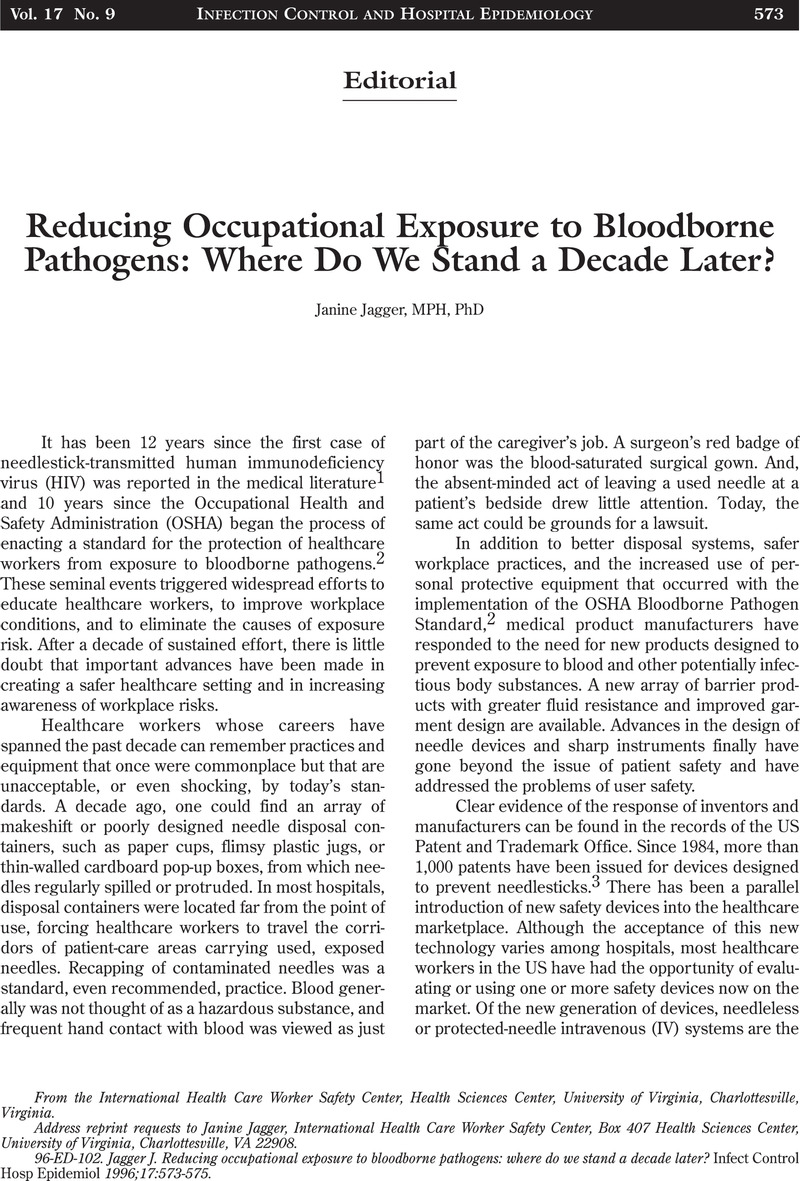Crossref Citations
This article has been cited by the following publications. This list is generated based on data provided by Crossref.
Calabro, Karen
Weltge, Arlo
Parnell, Susan
Kouzekanani, Kamiar
and
Ramirez, Elda
1998.
Intervention for medical students: Effective infection control.
American Journal of Infection Control,
Vol. 26,
Issue. 4,
p.
431.
&NA;
1999.
Preventing Needlesticks During Phlebotomy.
American Journal of Nursing,
Vol. 99,
Issue. 5,
p.
24AA.
Kanter, Lewis J.
and
Siegel, Charles
2003.
Needle sticks and adverse outcomes in office-based allergy practices.
Annals of Allergy, Asthma & Immunology,
Vol. 90,
Issue. 4,
p.
389.
Grimmond, T.
Rings, T.
Taylor, C.
Creech, R.
Kampen, R.
Kable, W.
Mead, P.
Mackie, P.
and
Pandur, R.
2003.
Sharps injury reduction using Sharpsmart™—a reusable sharps management system.
Journal of Hospital Infection,
Vol. 54,
Issue. 3,
p.
232.
Kanter, Lewis
2006.
Accidental needle stick prevention: an important, costly, unsafe policy revisited.
Annals of Allergy, Asthma & Immunology,
Vol. 97,
Issue. 1,
p.
7.
Chen, Guang X.
and
Jenkins, E. Lynn
2007.
Potential work‐related bloodborne pathogen exposures by industry and occupation in the United States Part I: An emergency department‐based surveillance study.
American Journal of Industrial Medicine,
Vol. 50,
Issue. 3,
p.
183.
Hassan, Z.M.
Wahsheh, M.A.
Shishani, K.R.
and
Pryor, E.R.
2008.
Hepatitis needs assessment among Jordanian healthcare workers.
International Nursing Review,
Vol. 55,
Issue. 2,
p.
142.
Whitby, Michael
McLaws, Mary-Louise
and
Slater, Karen
2008.
Needlestick injuries in a major teaching hospital: The worthwhile effect of hospital-wide replacement of conventional hollow-bore needles.
American Journal of Infection Control,
Vol. 36,
Issue. 3,
p.
180.
Petrucci, Cristina
Alvaro, Rosaria
Cicolini, Giancarlo
Cerone, Marina Pisegna
and
Lancia, Loreto
2009.
Percutaneous and Mucocutaneous Exposures in Nursing Students: An Italian Observational Study.
Journal of Nursing Scholarship,
Vol. 41,
Issue. 4,
p.
337.
Grimmond, Terry
Bylund, Suzann
Anglea, Candace
Beeke, Lou
Callahan, Angela
Christiansen, Erik
Flewelling, Kelly
McIntosh, Kathleen
Richter, Kay
and
Vitale, Monica
2010.
Sharps injury reduction using a sharps container with enhanced engineering: A 28 hospital nonrandomized intervention and cohort study.
American Journal of Infection Control,
Vol. 38,
Issue. 10,
p.
799.
Cheung, Kin
Ching, Shirley Siu Yin
Chang, Katherine Ka Pik
and
Ho, Shuk Ching
2012.
Prevalence of and risk factors for needlestick and sharps injuries among nursing students in Hong Kong.
American Journal of Infection Control,
Vol. 40,
Issue. 10,
p.
997.
Park, Soonmi
Jeong, Ihn Sook
and
Jun, Seong Sook
2013.
Effect of Sharps Injury Prevention Program on the Incidence and Reporting of Sharp Injury among Nurses.
Korean Journal of Nosocomial Infection Control,
Vol. 18,
Issue. 1,
p.
15.
Johnson, Cara Thurman
and
Hessels, Amanda J.
2024.
Associations between negative patient safety climate and infection prevention practices.
American Journal of Infection Control,
Vol. 52,
Issue. 9,
p.
1102.



